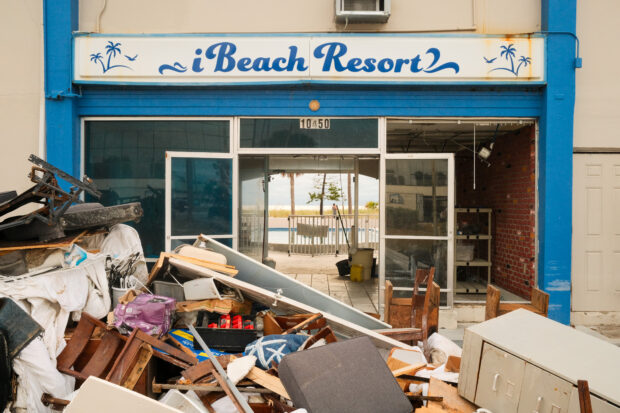Milton, the Atlantic’s strongest hurricane this year, is set to approach the Florida peninsula as a catastrophic Category 5 storm, bearing down on a region still struggling to recover from Helene’s devastation.
Milton’s top wind speed slowed slightly to 165 miles (265 kilometers) per hour, the U.S. National Hurricane Center said in its latest advisory. The system was expected to glance off Mexico’s Yucatan Peninsula on Tuesday before heading toward Florida on Wednesday.
“While fluctuations in intensity are expected, Milton is forecast to remain an extremely dangerous hurricane through landfall in Florida,” NHC Forecaster Richard Pasch wrote in his outlook. Air pressure in the eye of the storm fell to near a record low, the NHC said, highlighting Milton’s extraordinary intensity.
Milton now tops Hurricane Beryl, which raked Texas, Mexico and the Caribbean in July, as the most powerful Atlantic storm this season. With winds this intense, Milton is capable of collapsing homes, flattening trees and triggering power outages that could last weeks to months. It’s difficult for hurricanes to maintain their maximum strength for long, however, so Milton’s winds may drop as it nears Florida’s west coast. Only four Category 5 hurricanes have hit the U.S. mainland, including Michael, which struck Florida’s panhandle in 2018.
Widespread electricity outages are likely and a small shift in Milton’s trajectory can determine whether it strikes a densely populated area, said Florida Governor Ron DeSantis, who has declared an emergency in 51 counties.
“Please, if you are in the Tampa Bay area, you need to evacuate,” Kevin Guthrie, the director of the Florida Division of Emergency Management, said at a briefing Monday. “Drowning deaths due to storm surge are 100% preventable if you leave.”
Officials in the Yucatan Peninsula issued their own evacuation calls as the storm lashed the coast with wave heights forecast to top 19 feet (six meters). Mexican President Claudia Sheinbaum and Yucatan Governor Joaquin Diaz Mena urged citizens in the area to follow official instructions and go to shelters to stay safe. Authorities have also shut ports in the Gulf of Mexico and suspended schools in some municipalities of Quintana Roo state.
It isn’t clear exactly where in Florida Milton will make landfall. Various computer forecast models are at odds, and the hurricane center says errors of as much as 100 miles are possible in the days before a storm comes ashore. Milton likely will make landfall between 5 p.m. and 9 p.m. local time Wednesday, said Tyler Roys, a meteorologist with AccuWeather Inc.
“Milton’s remarkable rapid intensification is continuing,” Eric Blake, a forecaster at the NHC wrote in his outlook. Only two other hurricanes — Wilma in 2005 and Felix in 2007 — have strengthened as quickly, he added.
Milton’s jump in strength comes from hot Gulf of Mexico waters that also intensified the deadly Helene less than two weeks ago. Roys said a ridge of high pressure that’s setting temperature records in Phoenix and across the Southwest is helping steer Milton on an unusual track from west to east across the Gulf. No storm has blazed such a path since 1900.
Milton likely will cause $60 billion to $80 billion in damage and losses, Chuck Watson, a disaster modeler at Enki Research, said in an X post. Moody’s RMS Event Response, meanwhile, estimated privately insured losses could range from $8 billion to $14 billion, with another $2 billion covered by the National Flood Insurance Program.
In addition to packing ferocious winds, Milton is forecast to push a wall of water on shore that may reach as high as 15 feet in Tampa Bay, the NHC said.
Hurricane Helene brought “the most significant surge this area has seen in quite some time, and we’re already going to top that just two weeks later,” said Matt Anderson, a meteorologist for the National Weather Service in Tampa. “We’re now expecting the worst storm surge we’ve seen in Tampa Bay in recorded history just given the track, the intensity, and where Milton is predicted to make landfall.”
NASA and SpaceX have postponed Thursday’s launch of the agency’s multibillion-dollar Europa Clipper mission to explore one of Jupiter’s moons. The agency and SpaceX have launch opportunities until Nov. 6.
Milton will be the second major storm to strike Florida in less than two weeks and the fifth hurricane to hit the U.S. this year. At least 227 people died when Hurricane Helene struck Florida’s Big Bend area in late September and then spread flooding into the Appalachian Mountains, wreaking havoc across the region. Nearly half of all hurricane deaths come from drowning caused by storm surge and inland flooding.
Milton threatens to inflict wind damage in the northern two-thirds of Florida’s citrus belt this week, according to Commodity Weather Group. Orange juice futures traded in New York rose as much as 4.3% on Monday. For the second time in two weeks, Amtrak has canceled some trains in Florida and halted others at Jacksonville, the federally funded rail carrier said.
US natural gas futures sank more than 4% as Milton headed toward Florida’s western coastline. Traders are anticipating a drop in demand for gas to power plants if the storm knocks out electricity. Meanwhile, Chevron Corp. shut in oil production at the Blind Faith platform in the Gulf ahead of the hurricane.
In addition to Milton, the hurricane center is now watching an area of low pressure between Florida’s east coast and the Bahamas that has a 10% chance of becoming a tropical cyclone in the next week.
Photo: Piles of debris from Hurricane Helene remain uncollected ahead of Hurricane Milton’s expected landfall in Treasure Island, Fla., on Oct. 7, 2024. Photographer: Tristan Wheelock/Bloomberg





















 Loss Uncertainty High Amid ‘Rapid Softening’: Liberty Mutual Exec
Loss Uncertainty High Amid ‘Rapid Softening’: Liberty Mutual Exec  Hawaii’s Housing Market Faces Challenges Due to Construction Defect Litigation: Study
Hawaii’s Housing Market Faces Challenges Due to Construction Defect Litigation: Study  ‘Bleak’ Data: Insurance Co. Entry Level Hiring Expectations Hit Low Point
‘Bleak’ Data: Insurance Co. Entry Level Hiring Expectations Hit Low Point  An Insurance Journalist’s Perspective on Southern California’s Wildfires
An Insurance Journalist’s Perspective on Southern California’s Wildfires 